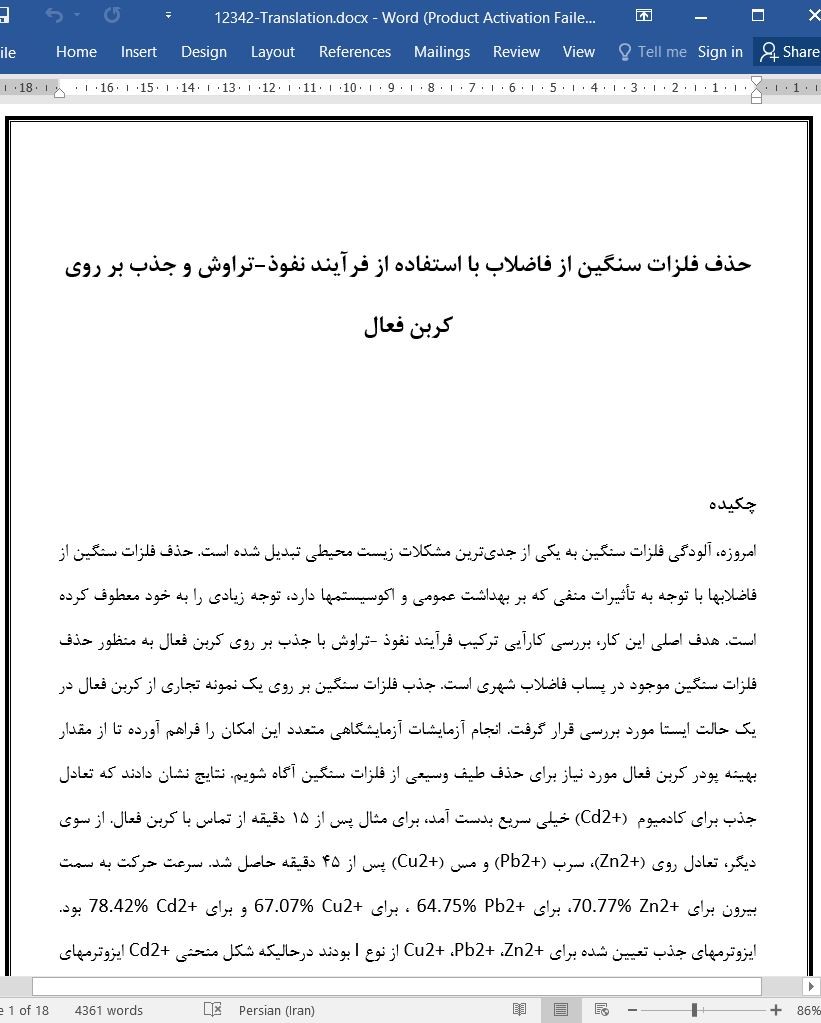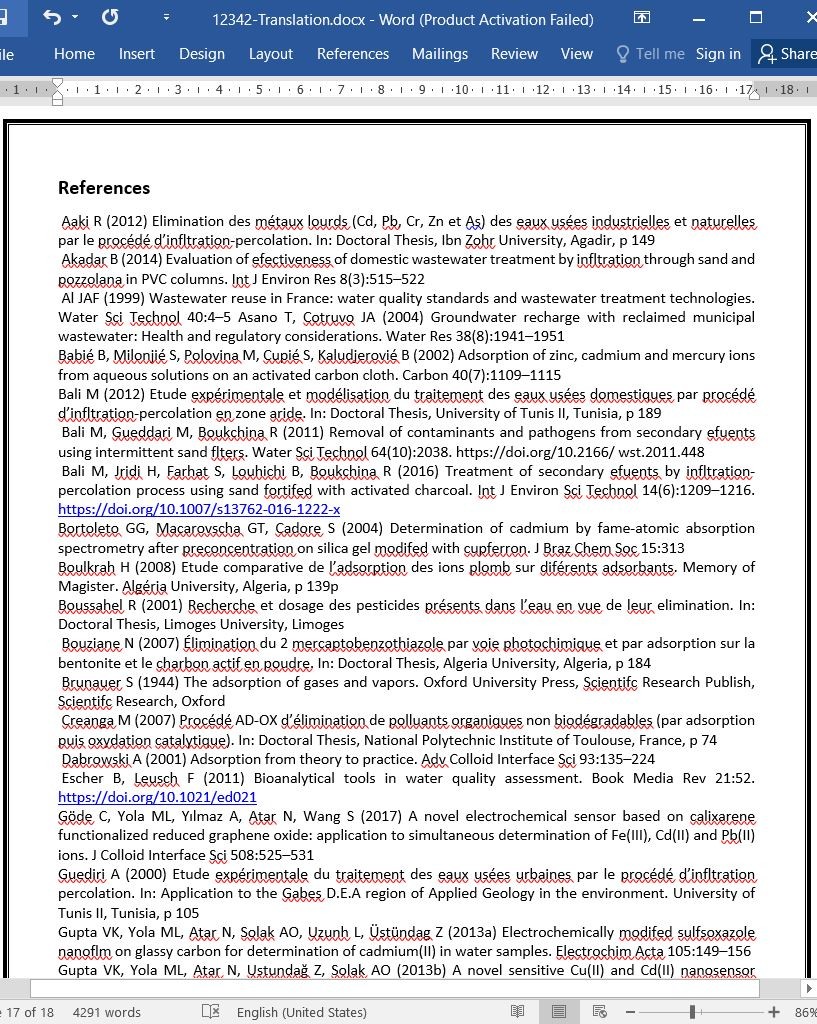
حذف فلزات سنگین از فاضلاب با استفاده از فرآیند نفوذ-تراوش و جذب بر روی کربن فعال
چکیده
امروزه، آلودگی فلزات سنگین به یکی از جدیترین مشکلات زیست محیطی تبدیل شده است. حذف فلزات سنگین از فاضلابها با توجه به تأثیرات منفی که بر بهداشت عمومی و اکوسیستمها دارد، توجه زیادی را به خود معطوف کرده است. هدف اصلی این کار، بررسی کارآیی ترکیب فرآیند نفوذ -تراوش با جذب بر روی کربن فعال به منظور حذف فلزات سنگین موجود در پساب فاضلاب شهری است. جذب فلزات سنگین بر روی یک نمونه تجاری از کربن فعال در یک حالت ایستا مورد بررسی قرار گرفت. انجام آزمایشات آزمایشگاهی متعدد این امکان را فراهم آورده تا از مقدار بهینه پودر کربن فعال مورد نیاز برای حذف طیف وسیعی از فلزات سنگین آگاه شویم. نتایج نشان دادند که تعادل جذب برای کادمیوم (Cd2+) خیلی سریع بدست آمد، برای مثال پس از 15 دقیقه از تماس با کربن فعال. از سوی دیگر، تعادل روی (Zn2+)، سرب (Pb2+) و مس (Cu2+) پس از 45 دقیقه حاصل شد. سرعت حرکت به سمت بیرون برای Zn2+ 70.77%، برای Pb2+ 64.75%، برای Cu2+ 67.07% و برای Cd2+ 78.42% بود. ایزوترمهای جذب تعیین شده برای Zn2+، Pb2+، Cu2+ از نوع I بودند درحالیکه شکل منحنی Cd2+ ایزوترمهای نوع II را نشان داد. این ایزوترمها ظرفیت پودر کربن فعال را در جذب کادمیوم، بهتر از سایر فلزات سنگین بررسی شده نشان میدهند.
مقدمه
فلزات سنگین گونههای خطرناکی هستند که مسائل مختلف زیست محیطی و سلامتی را سبب میشوند (Göde و همکاران، 2017). بیشتر صنایع، فاضلاب و پسابهای حاوی مواد سمی خود را که عمدتاً فلزات سنگین هستند به سیستمهای آبی بدون تصفیه تخلیه میکنند که این مشکل زیست محیطی بزرگی است. انتشار بیش از حد این آلایندهها حاکی از مشکل خاصی است چرا که آنها زیست تخریب پذیر نیستند (Boussahel، 2001). این آلایندهها با توجه به خصوصیات فیزیکی-شیمیایی متفاوتی که دارند، خطرات یکسانی را برای محیط زیست (Houas و همکاران 1999) و سلامت در بر ندارند.
نتیجه گیری
هدف اصلی این کار این بود که نوع تعادل جذبی فلزات سنگین مورد مطالعه را با ترکیب نفوذ-تراوش و فرایندهای جذب پودر کربن فعال (PAC)، مدلسازی و طبقه بندی کند. این آزمایشات نشان دادند که ترکیب این دو فرایند موجب بهبود تصفیه پسابهای ثانویه میشود. تکنیک نفوذ-تراوش که در یک ستون در مقیاس آزمایشگاهی طبق یک برنامه 4 روز تغذیه و 3 روز خشک کردن اعمال شده، به نظر میرسد که سیستم پایداری برای حذف آلایندههایی مثل مواد آلی و آمونیوم باشد. با این حال، این امر در مورد کاهش فلزات سنگین، زیاد عملی نیست. علاوه براین، کربن فعال یک ماده جاذب مؤثر است که به دلیل سطح ویژه بالایی که دارد میتواند به حذف رضایتبخش ریزآلاینده های موجود در فاضلاب شهری کمک کند.
نتایج نشان دادند که ترکیب نفوذ-تراوش و جذب بر روی فرایندهای پودر کربن فعال (PAC)موجب افزایش نرخ کاهش فلزات سنگین میشود.
ایزوترمهای جذب نشان دادند که جذب Zn2+، Pb2+ و Cu2+ از نوع I است، درحالیکه Cd2+ دارای ایزوترم نوع IIمیباشد. این فلز تحت یک فرایند جذب تک لایهای قرار گرفته است که قدرت اتصال آن و بنابراین حذف آن از فاضلاب را افزایش میدهد.
Abstract
Heavy metal pollution has become one of the most serious environmental problems nowadays. The removal of heavy metals from wastewaters has attracted a considerable attention because of their adverse efects on public health and ecosystems. The main objective of this work was to investigate the efciency of the coupling of infltration-percolation process with adsorption on activated carbon in the removal of heavy metals contained in urban wastewater efuents. The adsorption of heavy metals on a commercial sample of activated carbon was studied in a static mode. Several laboratory experiments made it possible to distinguish the optimum quantity of powdered activated carbon necessary to remove a large range of heavy metals. Results showed that the equilibrium of the adsorption was reached very quickly for cadmium (Cd2+), i.e., after 15 min of contact with the activated carbon. On the other hand, the equilibrium of zinc (Zn2+), lead (Pb2+) and copper (Cu2+) was achieved after 45 min. The withdrawal rates were 70.77% for Zn2+, 64.75% for Pb2+, 67.07% for Cu2+ and 78.42% for Cd2+. The adsorption isotherms determined for Zn2+, Pb2+, Cu2+ were of type I, while the shape of the Cd2+ curve showed a type II isotherm. These isotherms confrm the capacity of the powdered activated carbon to adsorb cadmium better than the other studied heavy metals.
Introduction
Heavy metals are dangerous species which induce various environmental and health problems (Göde et al. 2017). Most industries unload wastewater and efuent containing toxic materials, mainly heavy metals, into aquatic systems without treatment, which is a major environmental problem. The excessive release of these pollutants presents a particular problem because they are not biodegradable (Boussahel 2001). These pollutants do not all have the same risks to the environment (Houas et al. 1999) and to health because of their diferent physicochemical properties.
Conclusion
The main objective of this work was to model and classify the type of adsorption equilibrium of the heavy metals studied by coupling the infltration-percolation and PAC adsorption processes. The experiments showed that the coupling of the two processes improves the purifcation of the secondary efuents. The infltration-percolation technique, applied at a laboratory scale column according to a 4-day feeding—3-day drying schedule using a hydraulic load of 0.27 m/day, appears to be a sustainable system for removing pollutants such as organic matter and ammonium. However, it is less efective regarding heavy metal reduction. Furthermore, activated carbon is an efective adsorbent which can contribute to the satisfactory elimination of micropollutants contained in urban wastewaters thanks to its high specifc surface area.
Results demonstrated that the coupling of infltrationpercolation and adsorption on PAC processes increases the abatement rate of heavy metals.
The adsorption isotherms showed that the adsorption of Zn2+, Pb2+ and Cu2+ is of type I, while the Cd2+ has a type II isotherm. This metal has undergone a multilayer adsorption which enhances its attachment and therefore its removal from wastewater.
چکیده
مقدمه
موضوعات و روشها
نتایج و بحث
ارزیابی جذب فلزات سنگین بر روی پودر کربن فعال (PAC)
بررسی اثربخشی ترکیب نفوذ-تراوش و جذب بر روی پودر کربن فعال (PAC) در تصفیه فاضلاب شهری
شبیه سازی تعادل جذب
نتیجه گیری
منابع
Abstract
Introduction
Materials and methods
Results and discussion
Evaluation of the adsorption of heavy metals on PAC
Study of the efciency of the coupling of infltration percolation and adsorption on PAC in the treatment of urban wastewater
Simulation of adsorption equilibrium
Conclusion
References
- اصل مقاله انگلیسی با فرمت ورد (word) با قابلیت ویرایش
- ترجمه فارسی مقاله با فرمت ورد (word) با قابلیت ویرایش، بدون آرم سایت ای ترجمه
- ترجمه فارسی مقاله با فرمت pdf، بدون آرم سایت ای ترجمه



